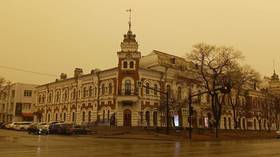Sky turns bright orange over Far Eastern Russian city (VIDEOS)

A dust storm sweeping Amur Region in Russia’s Far East has turned the sky bright orange – an unusual phenomenon captured by local residents in photos and videos.
A southwestern cyclone that hit the region’s capital, Blagoveshchensk, on Wednesday brought sand and dirt from China, according to weather experts. China has also suffered severe dust storms over the past month due to strong winds from Mongolia’s Gobi Desert.
According to the local meteorological center, when air currents pass the territory of Mongolia and China, they raise dust, sand and particles of soil, taking them into the atmosphere and painting the sky orange or yellow.
Residents of both Blagoveshchensk and neighboring settlements shared footage of the orange sky on social media.
Some likened the images to recent Hollywood blockbusters, The Martian and Dune.
Local emergency services warned that the storm is expected to continue through March 29, and advised residents to take measures to protect their eyes and respiratory systems from the dust.
According to a recent report by the World Meteorological Organization (WMO), the entire area from Mongolia to northern China was in the grip of one of the worst sand and dust storms in a decade between March 14 and March 16. The agency noted that the storm had caused a number of casualties in Mongolia.












